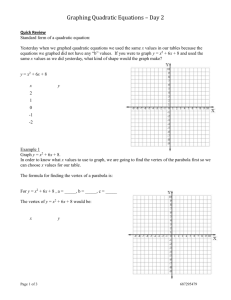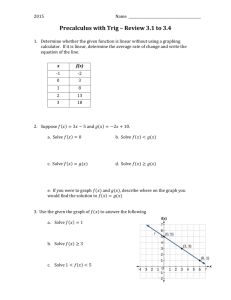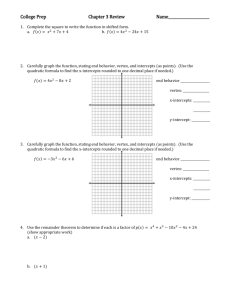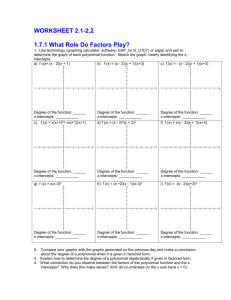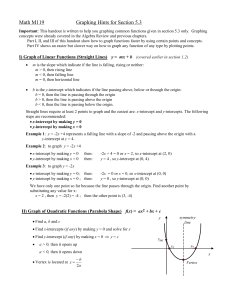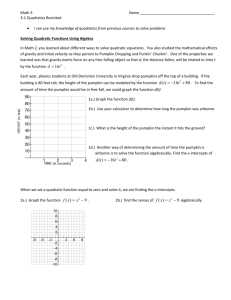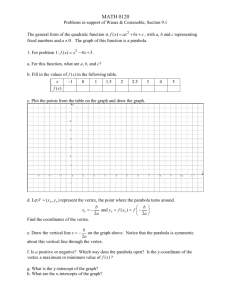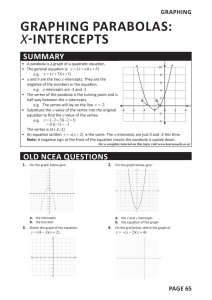Lesson 3-3 Practice
advertisement
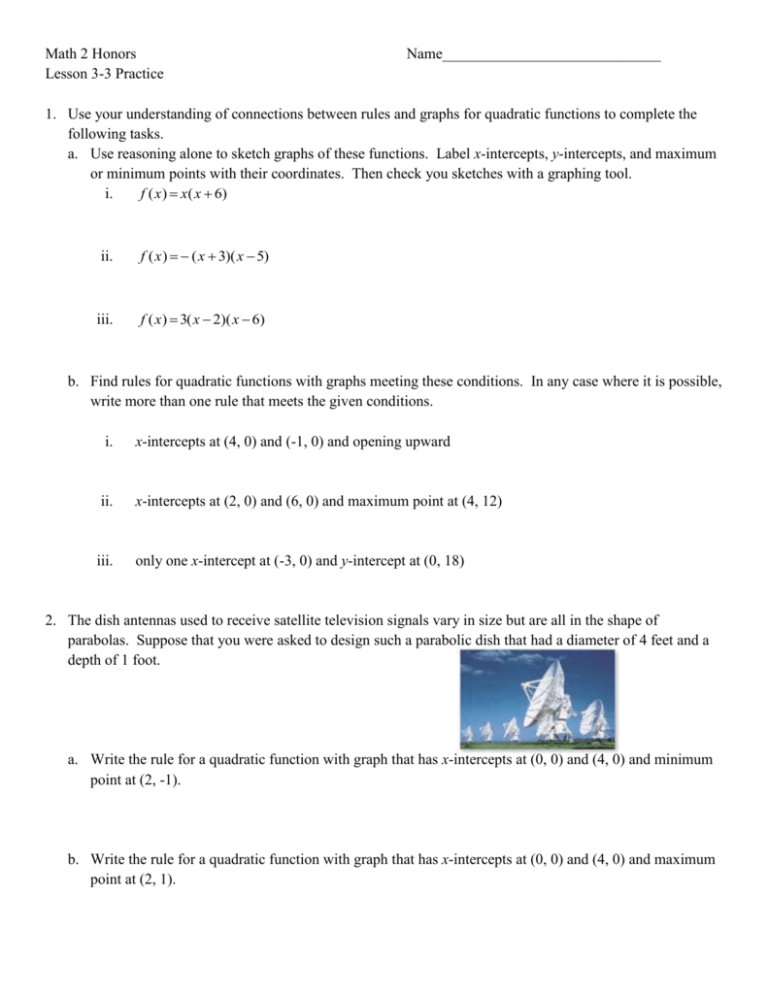
Math 2 Honors Lesson 3-3 Practice Name_____________________________ 1. Use your understanding of connections between rules and graphs for quadratic functions to complete the following tasks. a. Use reasoning alone to sketch graphs of these functions. Label x-intercepts, y-intercepts, and maximum or minimum points with their coordinates. Then check you sketches with a graphing tool. i. f ( x ) x( x 6) ii. f ( x ) ( x 3)( x 5) iii. f ( x ) 3( x 2)( x 6) b. Find rules for quadratic functions with graphs meeting these conditions. In any case where it is possible, write more than one rule that meets the given conditions. i. x-intercepts at (4, 0) and (-1, 0) and opening upward ii. x-intercepts at (2, 0) and (6, 0) and maximum point at (4, 12) iii. only one x-intercept at (-3, 0) and y-intercept at (0, 18) 2. The dish antennas used to receive satellite television signals vary in size but are all in the shape of parabolas. Suppose that you were asked to design such a parabolic dish that had a diameter of 4 feet and a depth of 1 foot. a. Write the rule for a quadratic function with graph that has x-intercepts at (0, 0) and (4, 0) and minimum point at (2, -1). b. Write the rule for a quadratic function with graph that has x-intercepts at (0, 0) and (4, 0) and maximum point at (2, 1). 3. Find coordinates of x-intercepts, y-intercept, and maximum or minimum points on the graphs of these quadratic functions. Show how the answers can be obtained by reasoning with the symbolic forms. Think strategically about when and how your answers for one part can help you with the next part. a. f ( x ) x (7 x ) b. f ( x ) x (7 x ) c. f ( x ) ( x 3)( x 5) d. f ( x ) ( x 3)( x 5) e. f ( x ) ( x 3)( x 8) f. f ( x ) ( x 3)( x 8) g. f ( x ) 2( x 3)( x 8) h. f ( x ) 2( x 3)( x 8) 4. Write rules for quadratic functions with graphs that meet these conditions: a. x-intercepts at (0, 0) and (6, 0) with graph opening upward b. x-intercepts at (-2, 0) and (6, 0) with graph opening upward c. x-intercepts at (-4, 0) and (-6, 0) with graph opening downward d. x-intercepts at (2, 0) and (6, 0) with minimum point at (4, -8) e. x-intercepts at (2, 0) and (6, 0) with maximum point at (4, 2) f. x-intercepts at (-2, 0) and (6, 0) with y-intercept at (0, -60) 5. Consider the graph of f ( x ) ( x 3)( x 4). a. What are the x-intercepts of the graph? b. Why does the graph of the function g ( x ) ( x 3)( x 4) 2 have different x-intercepts than f ( x ) ? c. Why does the graph of the function h( x ) 2( x 3)( x 4) have the same x-intercepts as f ( x ) ? 6. Based on your earlier studies, you know that two points determine a line. Given the coordinates of the points, you can write an equation y ax b for the line. a. How many points do you think are needed to determine the equation of a parabola? b. Does it make any difference which points you are given? Explain your thinking. 7. Classify each of the following number as rational or irrational. a. 7 b. 136 5 c. d. 1 9 e. ( 5) 2 f. g. 18 4 h. 0.81 250 2 3 8. Write a function rule for the graph. 9. Write a function rule for the graph. 10. Write a function rule for the graph.

